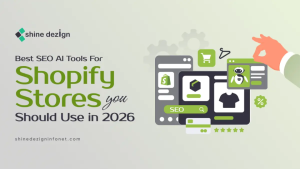Table of Contents
Shopify has emerged as a powerhouse platform, empowering businesses of all sizes to establish and grow their online presence. However, merely setting up a Shopify store is not enough to guarantee success in today’s competitive market. To truly thrive and scale your e-commerce business, it’s essential to harness the full potential of Shopify’s development capabilities.
In this comprehensive guide, we’ll delve into 20 essential Shopify development tips that can elevate your store’s performance, enhance user experience, and drive sustainable growth
20 Essential Shopify Development Tips
1. Optimize for Mobile
A responsive design ensures seamless functionality and navigation across diverse screen sizes, enhancing user experience. Beyond satisfying clients, mobile optimization also boosts search engine rankings, aligning with Google’s mobile first-indexing criteria.
By prioritizing mobile usability, you not only cater to the preferences of modern consumers but also position your store favorably in the competitive digital marketplace. With mobile commerce continuing to thrive, this strategic approach becomes increasingly indispensable for sustaining and growing online businesses.
2. Fast Loading Speed
Fast loading speed is crucial for eCommerce success. By optimizing your site’s loading time through various techniques like code minification, browser caching, image optimization, and CDNS, you create a seamless user experience. When your website loads quickly, visitors are more likely to stay engaged, leading to lower bounce rates.
Additionally, faster loading times can positively impact conversion rates as users are more likely to complete their transactions without frustration. Investing in optimizing loading speed demonstrates your commitment to providing smooth browsing experiences, ultimately contributing to increased customer satisfaction and loyalty.
3. Customize Theme Responsively
Having a responsive customized theme comes under Shopify development tips that help you to align with your brand identity. Ensure that your Shopify theme is not only visually appealing but also optimized and responsive for performance across devices. Tailor the design elements, color scheme and layout to create a unique and memorable shopping experience for your customers.
In addition, by investing in responsive customization, you can enhance user engagement, encourage longer site visits, and drive conversions. A cohesive and customized Shopify theme development strengthens brand perceptions and fosters trust, essential for long-term customer relationships.
4. Streamline Checkout Process
Optimizing the checkout process is vital to reducing cart abandonment and enhancing user satisfaction, Simplify the process by minimizing steps, enabling guest checkout, and offering diverse payment gateways for convenience.
Incorporate address autocomplete to expedite form completion and provide an order summary for transparency. Streamlining the checkout flow reduces friction and increases the likelihood of completed purchases. Therefore, by prioritizing usability and transparency, you can create a seamless experience that instills confidence in customers and encourages repeat business. A smooth checkout process is instrumental in fostering positive relationships and maximizing conversions, ultimately contributing to the success of your ecommerce venture.
5. Implement SEO Best Practices
Implementing Shopify SEO Services with best practices is an essential tip among Shopify development tips for driving organic traffic to your Shopify store. Another Shopify store optimization tip, start by optimizing your site for relevant keywords, incorporating themes into your product descriptions, titles, and headers.
Craft compelling meta tags and descriptions that entice users to click through from search engine results pages. Also, another Shopify eCommerce tips is to ensures your URL structure is SEO-friendly, using descriptive and keyword-rich URLs, take advantage of Shopify’s built-in SEO features and apps to monitor your site’s performance, track keyword rankings, and make data-driven optimizations.
By consistently optimizing your site for search engines, you can improve visibility, attract more qualified traffic, and ultimately boost sales.
6. Integrate Social Proof
Trust is the key and social proof is a potent tool for building credibility, By integrating elements like customer reviews, testimonials, and user-generated content into your Shopify store, you provide prospective customers with valuable insights from others’ experiences Showcasing positive feedback prominently helps instill confidence and assures potential buyers of the quality and reliability of your services or products.
This transparent approach facilitates informed purchasing decisions, as Shoppers feel more confident in their choices when they see others’ positive experiences. Utilizing social proof effectively strengthens trust in your brand and enhances your store’s reputation, ultimately driving sales and fostering long-term customer relationships.
7. Personalization
Personalization is pivotal in modern e-commerce marketing strategies. Utilize data-driven insights to tailor the shopping experience for each customer. Implement features such as personalized product recommendations, customized offers, and dynamically generated content to engage users on a deeper level. By understanding individual preferences and behavior patterns, you can enhance user satisfaction and increase conversion rates.
Personalization fosters a sense of connection and relevance, leading to improved customer loyalty and retention. Ultimately, by delivering tailored experiences, you can differentiate your brand in a competitive market and establish long-lasting relationships with your audience.
8. Enhanced Product Search
A robust product search functionality is crucial Shopify eCommerce tips for e-commerce success, especially with extensive product catalogs. Implementing advanced search features such as filters, sorting options, autocomplete suggestions, and predictive search significantly enhances user experience. These features enable users to quickly and effortlessly find desired products, increasing satisfaction and likelihood of conversion.
Investing in a search solution that delivers accurate results and intuitive experiences is paramount. By providing users with a seamless search experience, you improve engagement, reduce bounce rates, and ultimately drive sales. A comprehensive search functionality reflects a commitment to customer satisfaction and sets your e-commerce store apart from competitors.
9. Utilize Shopify Apps
Harnessing the power of Shopify apps can revolutionize your store’s capabilities. With a vast array of tools available in the Shopify App Store, you can tailor your store to meet specific needs. Whether it’s bolstering marketing strategies, streamlining customer support, or optimizing backend operations, there’s an app to suit every requirement.
Robust Shopify app development offers scalability and flexibility, allowing you to adapt to changing market trends and customer demands seamlessly. By leveraging Shopify apps, you unlock new avenues for growth, enhance user experience, and ultimately drive revenue. Embrace innovation and stay ahead of the competition by integrating the right apps into your Shopify store.
10. Secure Payment Processing
Securing online transactions is essential for e-commerce success. Select trusted payment gateways adhering to industry standards like PCI DSS (Payment Card Industry Data Security Standard). Enhance security with SSL encryption, fraud detection systems, and tokenization to protect customer data. By prioritizing secure payment processing, you instill trust in customers, reassuring them that their sensitive information is safe.
This builds confidence, encourages repeat purchases, and fosters a positive reputation for your brand. Additionally, compliance with regulations and standards demonstrates your commitment to maintaining high-security standards, further strengthening customer trust and loyalty in your business.
11. Optimize Product Pages
Optimizing product pages on your Shopify store is crucial for driving conversions. Visually appealing product images and compelling descriptions grab attention and entice visitors to make a purchase. Highlighting key features and benefits helps customers understand the value of your products. Incorporating social proof elements like customer reviews and ratings builds trust and credibility, reassuring potential buyers about the quality and satisfaction of your offerings.
By creating engaging, informative, and trustworthy product pages, you increase the likelihood of turning visitors into customers, ultimately boosting sales and fostering long-term relationships with your audience.
12. Implement Upselling and Cross-selling
Upselling and cross-selling tactics can significantly boost revenue in e-commerce. By incorporating product recommendation widgets, related product sections, and bundle offers, your prompt customers to explore additional items, increasing their average order value. Personalizing recommendations based on customer behavior and purchase history enhances relevance, making it more likely for customers to make additional purchases.
These Shopify optimization strategies not only drive immediate sales but also improve customer satisfaction by suggesting complementary products that meet their needs and preferences.
By implementing upselling and cross-selling effectively, you can maximize the value of each transaction and cultivate long-term customer relationships.
13. Email Marketing Automation
Email marketing automation revolutionizes the way businesses engage with customers by delivering timely, relevant messages throughout the customer journey. By segmenting your email list based on factors like demographics, purchase history, and engagement level, you can tailor content to individual preferences, increasing relevance and engagement.
Automated workflows enable you to send targeted messages at crucial touchpoints, such as welcome sequences, abandoned cart reminders, or post-purchase follow-ups, nurturing leads and driving sales effectively. With automation, you save time while delivering personalized experiences that strengthen customer relationships, boost brand loyalty, and ultimately drive revenue growth in the competitive landscape of e-commerce.
14. Monitor Analytics
Monitoring analytics is paramount for optimizing your Shopify store’s performance. Whether using Shopify’s native analytics tools or integrating third-party platforms, tracking key metrics like traffic, conversion rates, and customer acquisition costs is crucial. Analyzing this data provides valuable insights into trends, opportunities, and areas for improvement.
By leveraging these insights, you can make informed decisions to enhance user experience, refine marketing strategies, and streamline operations. Continuously monitoring analytics empowers you to adapt to changing market dynamics, stay ahead of competitors, and ultimately drive sustained growth and success for your e-commerce business.
15. A/B Testing
Optimizing your Shopify store is an ongoing process, and A/B testing plays a crucial role in determining the most effective strategies for your audience. Experiment with different elements such as design, copy, calls-to-action, and pricing to understand what resonates best.
By analyzing the results of these tests, you can refine your approach to maximize conversion rates and ultimately improve your return on investment (ROI). Continuously iterate based on insights gained from A/B testing to ensure that your store is always optimized for the best possible performance and customer experience.
16. Optimize for International Markets
Expanding your e-commerce business into international markets requires strategic optimization. Ensure your Shopify store caters to diverse audiences by implementing multilingual support and localizing content to resonate with different cultures. Offering currency conversion options simplifies transactions for customers worldwide.
Additionally, consider logistical challenges such as shipping and regulatory compliance to streamline operations across borders. By addressing these factors and tailoring your approach to each market’s unique needs, you can effectively penetrate international markets and unlock new growth opportunities for your business while fostering trust and loyalty among global customers.
17. Implement Retargeting Campaigns
Retargeting campaigns are essential for e-commerce success, enabling you to reconnect with potential customers who have expressed interest but haven’t completed a purchase. By deploying retargeting across social media, display ads, and email, you maintain visibility and encourage repeat visits. Tailoring messages and incentives based on user behavior enhances relevance, increasing the chances of conversion.
Through personalized outreach, you remind users of their initial interest, addressing potential hesitations and nudging them towards a purchase decision. Ultimately, retargeting campaigns maximize your marketing efforts by re-engaging with high-potential leads and guiding them back to your site for conversion.
18. Customer Support Integration
Integrating customer support tools like live chat, helpdesk systems, and chatbots into your Shopify store enhances the overall customer experience. These tools enable timely assistance and efficient query resolution, fostering long-term customer relationships and loyalty. By offering multiple communication channels, such as email, phone, and social media, you cater to diverse customer preferences and increase accessibility.
Consistent quality across all touchpoints ensures a seamless support experience, building trust and satisfaction. Providing exceptional customer support not only resolves issues promptly but also strengthens your brand reputation, ultimately driving customer retention and positive word-of-mouth referrals.
19. Regularly Update Content
Regularly updating content on your Shopify store is vital for maintaining customer engagement and encouraging repeat visits. By consistently refreshing product listings, blog posts, and promotional content, you can showcase new arrivals, spotlight seasonal offerings, and communicate brand updates effectively. Implementing a content calendar allows you to plan and schedule updates in advance, ensuring a steady stream of fresh content.
This not only keeps your store looking current and relevant but also helps to maintain consistent visibility among your audience. Ultimately, updating content regularly demonstrates your commitment to providing valuable and up-to-date information, fostering trust and loyalty with your customers.
20. Continuous Optimization
Continuous optimization is vital Shopify eCommerce tips for business success. Regularly monitoring performance metrics, gathering user feedback, and staying updated on industry trends allows you to adapt and evolve your Shopify store effectively. By iterating based on insights and learnings, you can enhance user experience, drive sustained growth, and maintain a competitive edge.
This iterative process ensures that your store remains relevant and meets the evolving needs of your customers. Embracing continuous optimization as a fundamental strategy enables you to stay ahead of the curve, maximize your store’s potential, and achieve long-term success in the dynamic e-commerce landscape.
Conclusion
Mastering Shopify development is a journey that requires dedication, creativity, and a commitment to excellence. By implementing these 20 essential Shopify development tips, you can optimize your Shopify store for success and position your e-commerce business for long-term growth and profitability. Whether you’re just starting out or looking to take your existing Shopify store to the next level, these tips will help you maximize your store’s potential and achieve your business goals.



















